Contract and Procurement Management
VerifiedAdded on 2023/04/21
|17
|4335
|384
AI Summary
This document discusses the evaluation of target price contracts under NEC ECC and the lack of possibility under JCT SBC or FIDIC Red Book contract. It also explores the role of insurance in construction contracts and the procedure of anticipating and managing potential disputes between parties under standard contract forms.
Contribute Materials
Your contribution can guide someone’s learning journey. Share your
documents today.
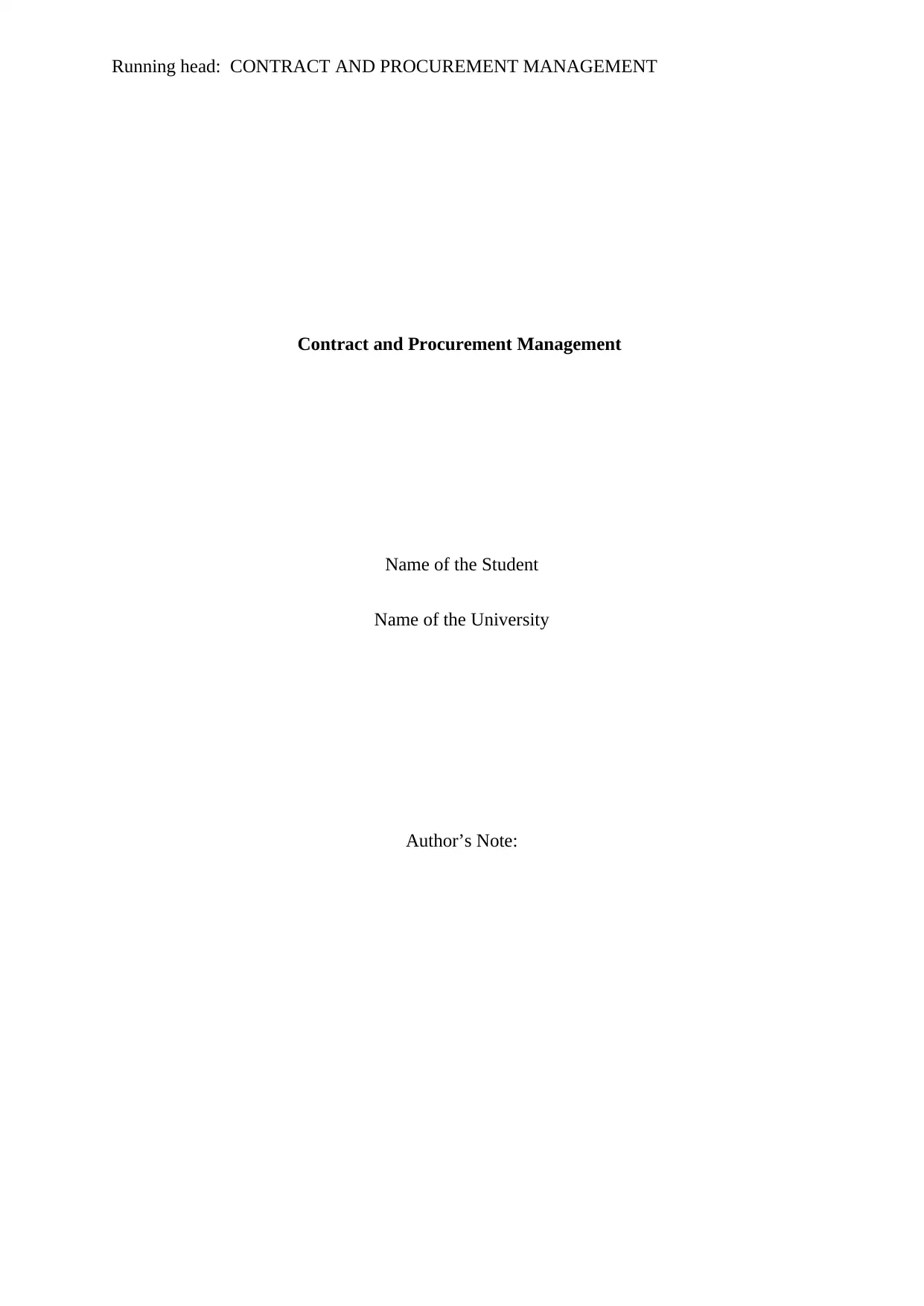
Running head: CONTRACT AND PROCUREMENT MANAGEMENT
Contract and Procurement Management
Name of the Student
Name of the University
Author’s Note:
Contract and Procurement Management
Name of the Student
Name of the University
Author’s Note:
Secure Best Marks with AI Grader
Need help grading? Try our AI Grader for instant feedback on your assignments.
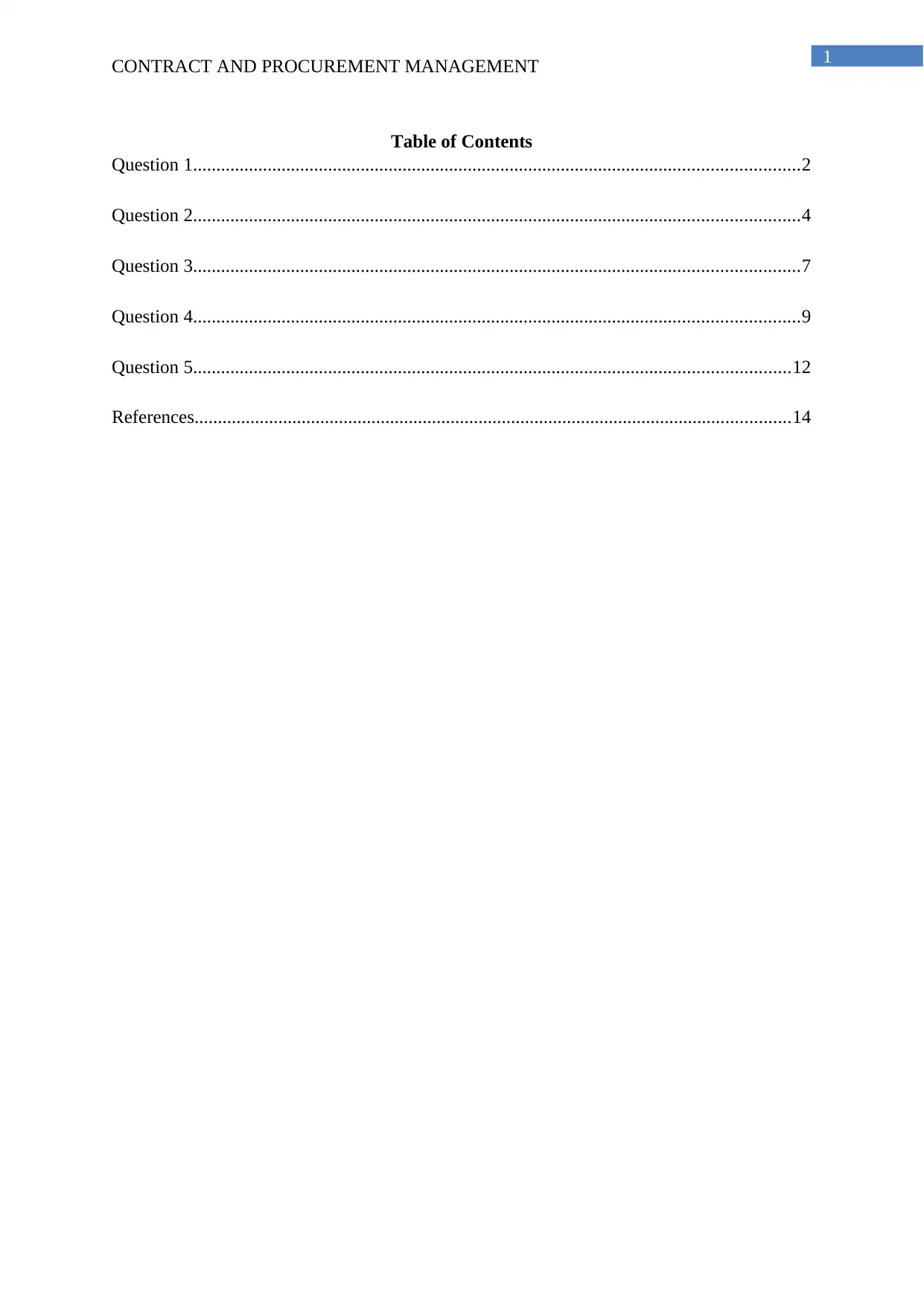
1
CONTRACT AND PROCUREMENT MANAGEMENT
Table of Contents
Question 1..................................................................................................................................2
Question 2..................................................................................................................................4
Question 3..................................................................................................................................7
Question 4..................................................................................................................................9
Question 5................................................................................................................................12
References................................................................................................................................14
CONTRACT AND PROCUREMENT MANAGEMENT
Table of Contents
Question 1..................................................................................................................................2
Question 2..................................................................................................................................4
Question 3..................................................................................................................................7
Question 4..................................................................................................................................9
Question 5................................................................................................................................12
References................................................................................................................................14
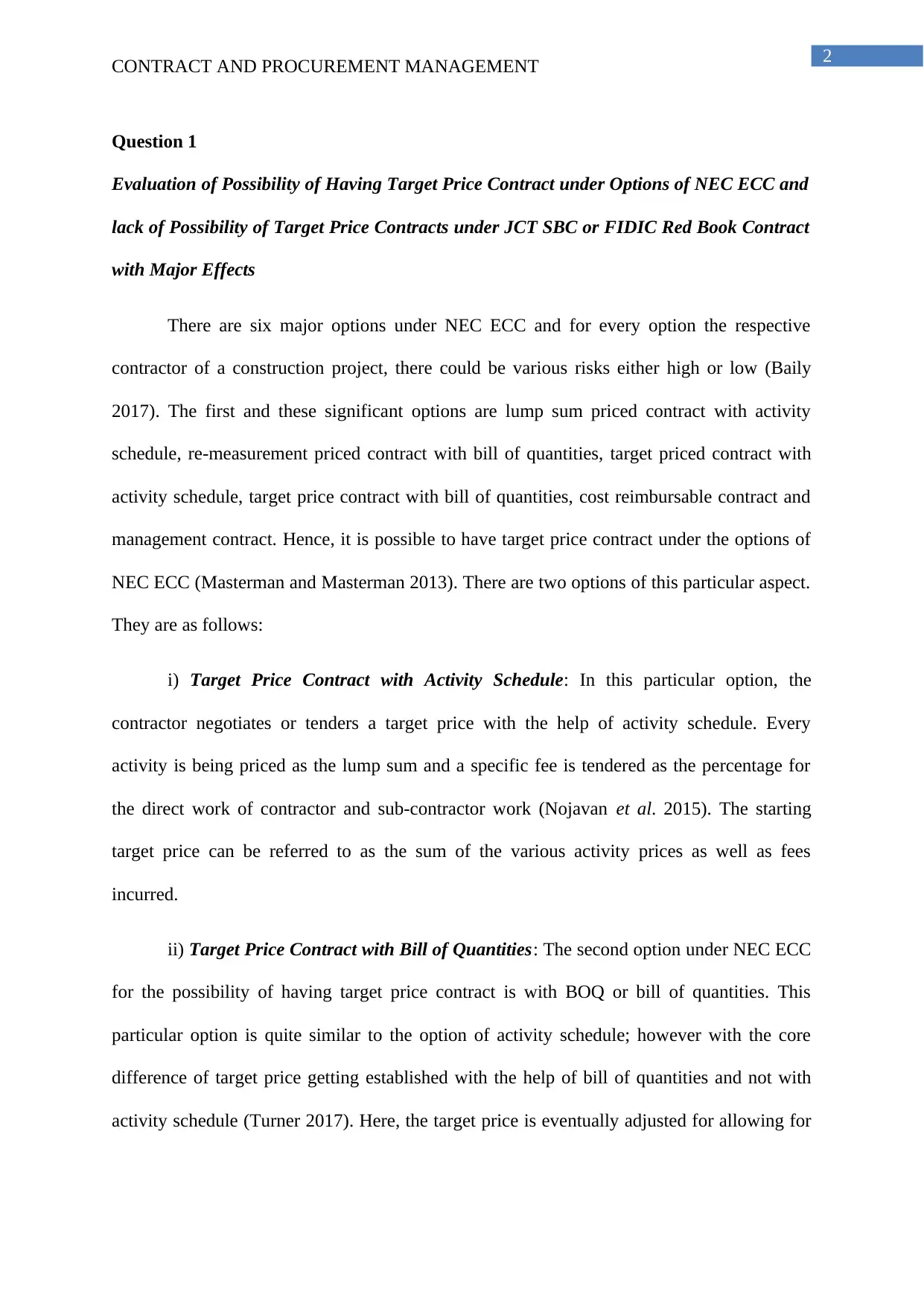
2
CONTRACT AND PROCUREMENT MANAGEMENT
Question 1
Evaluation of Possibility of Having Target Price Contract under Options of NEC ECC and
lack of Possibility of Target Price Contracts under JCT SBC or FIDIC Red Book Contract
with Major Effects
There are six major options under NEC ECC and for every option the respective
contractor of a construction project, there could be various risks either high or low (Baily
2017). The first and these significant options are lump sum priced contract with activity
schedule, re-measurement priced contract with bill of quantities, target priced contract with
activity schedule, target price contract with bill of quantities, cost reimbursable contract and
management contract. Hence, it is possible to have target price contract under the options of
NEC ECC (Masterman and Masterman 2013). There are two options of this particular aspect.
They are as follows:
i) Target Price Contract with Activity Schedule: In this particular option, the
contractor negotiates or tenders a target price with the help of activity schedule. Every
activity is being priced as the lump sum and a specific fee is tendered as the percentage for
the direct work of contractor and sub-contractor work (Nojavan et al. 2015). The starting
target price can be referred to as the sum of the various activity prices as well as fees
incurred.
ii) Target Price Contract with Bill of Quantities: The second option under NEC ECC
for the possibility of having target price contract is with BOQ or bill of quantities. This
particular option is quite similar to the option of activity schedule; however with the core
difference of target price getting established with the help of bill of quantities and not with
activity schedule (Turner 2017). Here, the target price is eventually adjusted for allowing for
CONTRACT AND PROCUREMENT MANAGEMENT
Question 1
Evaluation of Possibility of Having Target Price Contract under Options of NEC ECC and
lack of Possibility of Target Price Contracts under JCT SBC or FIDIC Red Book Contract
with Major Effects
There are six major options under NEC ECC and for every option the respective
contractor of a construction project, there could be various risks either high or low (Baily
2017). The first and these significant options are lump sum priced contract with activity
schedule, re-measurement priced contract with bill of quantities, target priced contract with
activity schedule, target price contract with bill of quantities, cost reimbursable contract and
management contract. Hence, it is possible to have target price contract under the options of
NEC ECC (Masterman and Masterman 2013). There are two options of this particular aspect.
They are as follows:
i) Target Price Contract with Activity Schedule: In this particular option, the
contractor negotiates or tenders a target price with the help of activity schedule. Every
activity is being priced as the lump sum and a specific fee is tendered as the percentage for
the direct work of contractor and sub-contractor work (Nojavan et al. 2015). The starting
target price can be referred to as the sum of the various activity prices as well as fees
incurred.
ii) Target Price Contract with Bill of Quantities: The second option under NEC ECC
for the possibility of having target price contract is with BOQ or bill of quantities. This
particular option is quite similar to the option of activity schedule; however with the core
difference of target price getting established with the help of bill of quantities and not with
activity schedule (Turner 2017). Here, the target price is eventually adjusted for allowing for
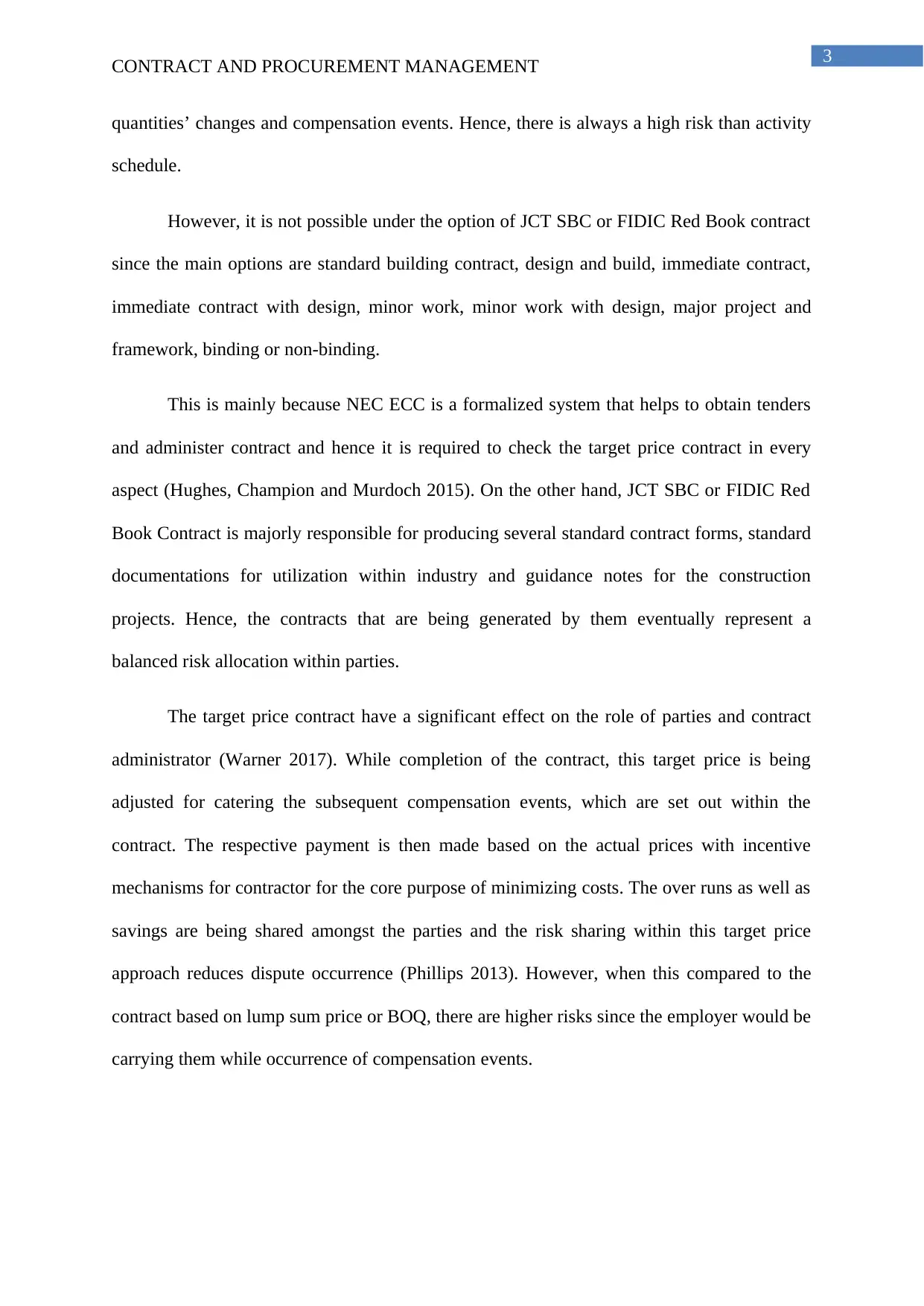
3
CONTRACT AND PROCUREMENT MANAGEMENT
quantities’ changes and compensation events. Hence, there is always a high risk than activity
schedule.
However, it is not possible under the option of JCT SBC or FIDIC Red Book contract
since the main options are standard building contract, design and build, immediate contract,
immediate contract with design, minor work, minor work with design, major project and
framework, binding or non-binding.
This is mainly because NEC ECC is a formalized system that helps to obtain tenders
and administer contract and hence it is required to check the target price contract in every
aspect (Hughes, Champion and Murdoch 2015). On the other hand, JCT SBC or FIDIC Red
Book Contract is majorly responsible for producing several standard contract forms, standard
documentations for utilization within industry and guidance notes for the construction
projects. Hence, the contracts that are being generated by them eventually represent a
balanced risk allocation within parties.
The target price contract have a significant effect on the role of parties and contract
administrator (Warner 2017). While completion of the contract, this target price is being
adjusted for catering the subsequent compensation events, which are set out within the
contract. The respective payment is then made based on the actual prices with incentive
mechanisms for contractor for the core purpose of minimizing costs. The over runs as well as
savings are being shared amongst the parties and the risk sharing within this target price
approach reduces dispute occurrence (Phillips 2013). However, when this compared to the
contract based on lump sum price or BOQ, there are higher risks since the employer would be
carrying them while occurrence of compensation events.
CONTRACT AND PROCUREMENT MANAGEMENT
quantities’ changes and compensation events. Hence, there is always a high risk than activity
schedule.
However, it is not possible under the option of JCT SBC or FIDIC Red Book contract
since the main options are standard building contract, design and build, immediate contract,
immediate contract with design, minor work, minor work with design, major project and
framework, binding or non-binding.
This is mainly because NEC ECC is a formalized system that helps to obtain tenders
and administer contract and hence it is required to check the target price contract in every
aspect (Hughes, Champion and Murdoch 2015). On the other hand, JCT SBC or FIDIC Red
Book Contract is majorly responsible for producing several standard contract forms, standard
documentations for utilization within industry and guidance notes for the construction
projects. Hence, the contracts that are being generated by them eventually represent a
balanced risk allocation within parties.
The target price contract have a significant effect on the role of parties and contract
administrator (Warner 2017). While completion of the contract, this target price is being
adjusted for catering the subsequent compensation events, which are set out within the
contract. The respective payment is then made based on the actual prices with incentive
mechanisms for contractor for the core purpose of minimizing costs. The over runs as well as
savings are being shared amongst the parties and the risk sharing within this target price
approach reduces dispute occurrence (Phillips 2013). However, when this compared to the
contract based on lump sum price or BOQ, there are higher risks since the employer would be
carrying them while occurrence of compensation events.
Secure Best Marks with AI Grader
Need help grading? Try our AI Grader for instant feedback on your assignments.
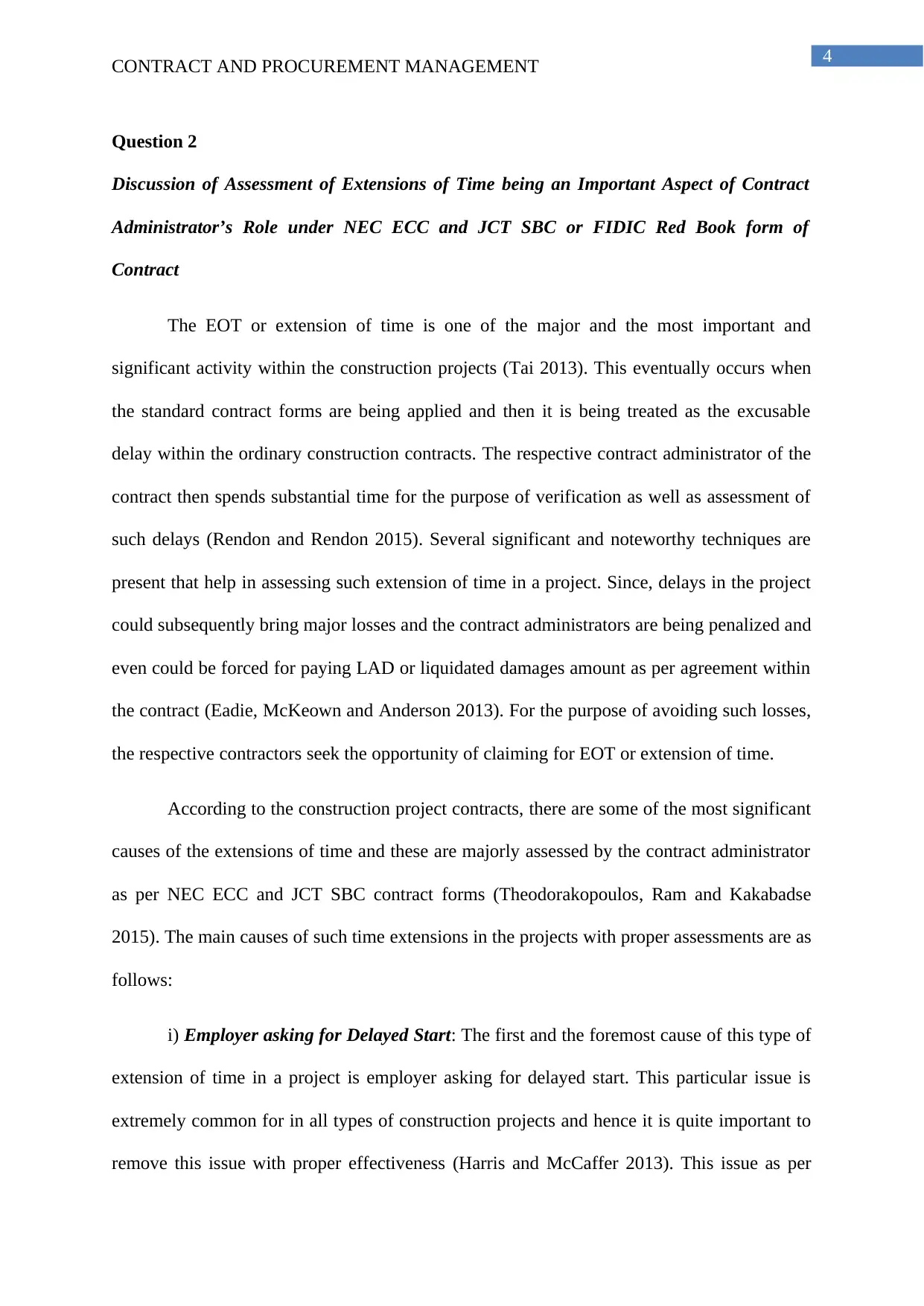
4
CONTRACT AND PROCUREMENT MANAGEMENT
Question 2
Discussion of Assessment of Extensions of Time being an Important Aspect of Contract
Administrator’s Role under NEC ECC and JCT SBC or FIDIC Red Book form of
Contract
The EOT or extension of time is one of the major and the most important and
significant activity within the construction projects (Tai 2013). This eventually occurs when
the standard contract forms are being applied and then it is being treated as the excusable
delay within the ordinary construction contracts. The respective contract administrator of the
contract then spends substantial time for the purpose of verification as well as assessment of
such delays (Rendon and Rendon 2015). Several significant and noteworthy techniques are
present that help in assessing such extension of time in a project. Since, delays in the project
could subsequently bring major losses and the contract administrators are being penalized and
even could be forced for paying LAD or liquidated damages amount as per agreement within
the contract (Eadie, McKeown and Anderson 2013). For the purpose of avoiding such losses,
the respective contractors seek the opportunity of claiming for EOT or extension of time.
According to the construction project contracts, there are some of the most significant
causes of the extensions of time and these are majorly assessed by the contract administrator
as per NEC ECC and JCT SBC contract forms (Theodorakopoulos, Ram and Kakabadse
2015). The main causes of such time extensions in the projects with proper assessments are as
follows:
i) Employer asking for Delayed Start: The first and the foremost cause of this type of
extension of time in a project is employer asking for delayed start. This particular issue is
extremely common for in all types of construction projects and hence it is quite important to
remove this issue with proper effectiveness (Harris and McCaffer 2013). This issue as per
CONTRACT AND PROCUREMENT MANAGEMENT
Question 2
Discussion of Assessment of Extensions of Time being an Important Aspect of Contract
Administrator’s Role under NEC ECC and JCT SBC or FIDIC Red Book form of
Contract
The EOT or extension of time is one of the major and the most important and
significant activity within the construction projects (Tai 2013). This eventually occurs when
the standard contract forms are being applied and then it is being treated as the excusable
delay within the ordinary construction contracts. The respective contract administrator of the
contract then spends substantial time for the purpose of verification as well as assessment of
such delays (Rendon and Rendon 2015). Several significant and noteworthy techniques are
present that help in assessing such extension of time in a project. Since, delays in the project
could subsequently bring major losses and the contract administrators are being penalized and
even could be forced for paying LAD or liquidated damages amount as per agreement within
the contract (Eadie, McKeown and Anderson 2013). For the purpose of avoiding such losses,
the respective contractors seek the opportunity of claiming for EOT or extension of time.
According to the construction project contracts, there are some of the most significant
causes of the extensions of time and these are majorly assessed by the contract administrator
as per NEC ECC and JCT SBC contract forms (Theodorakopoulos, Ram and Kakabadse
2015). The main causes of such time extensions in the projects with proper assessments are as
follows:
i) Employer asking for Delayed Start: The first and the foremost cause of this type of
extension of time in a project is employer asking for delayed start. This particular issue is
extremely common for in all types of construction projects and hence it is quite important to
remove this issue with proper effectiveness (Harris and McCaffer 2013). This issue as per
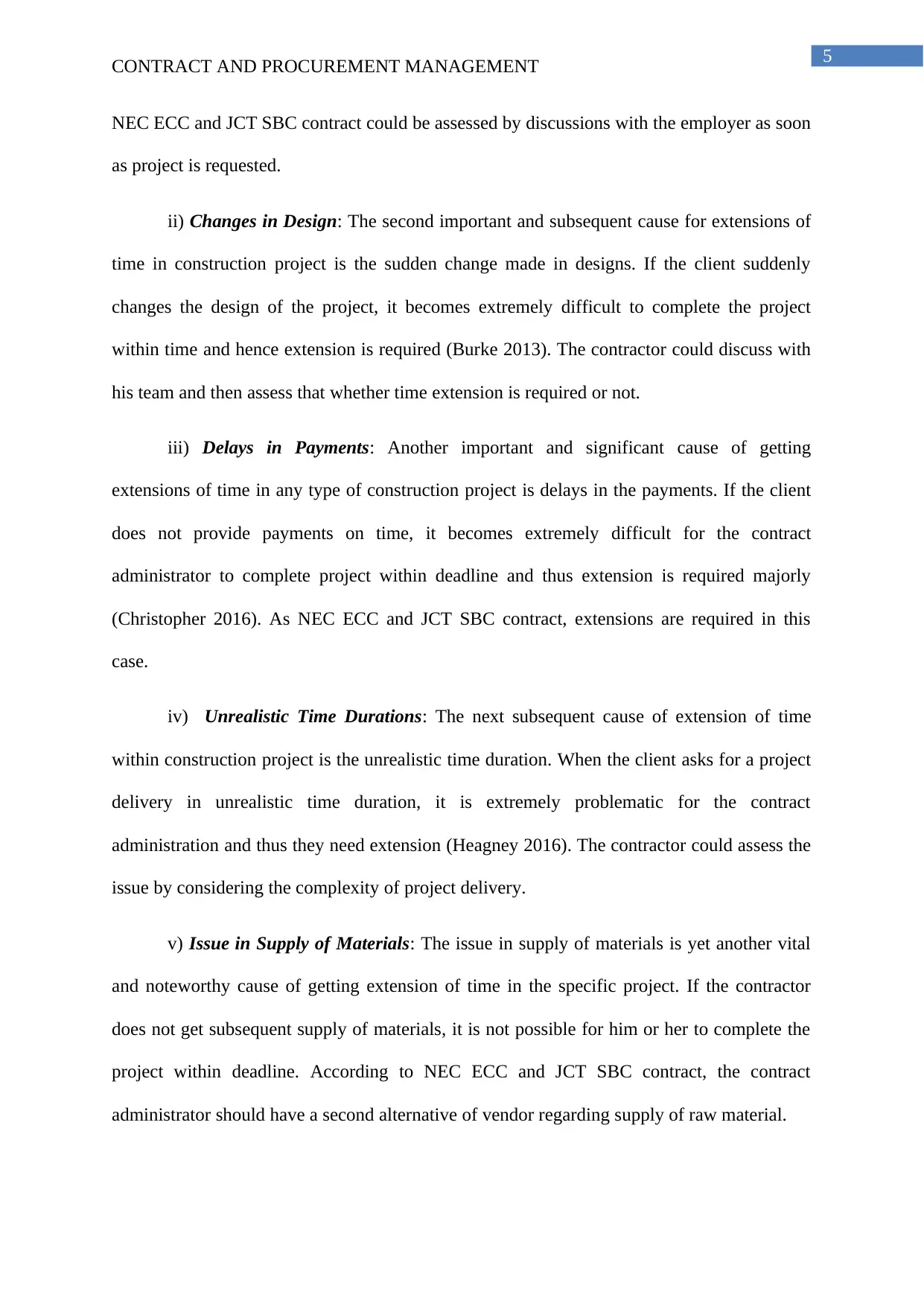
5
CONTRACT AND PROCUREMENT MANAGEMENT
NEC ECC and JCT SBC contract could be assessed by discussions with the employer as soon
as project is requested.
ii) Changes in Design: The second important and subsequent cause for extensions of
time in construction project is the sudden change made in designs. If the client suddenly
changes the design of the project, it becomes extremely difficult to complete the project
within time and hence extension is required (Burke 2013). The contractor could discuss with
his team and then assess that whether time extension is required or not.
iii) Delays in Payments: Another important and significant cause of getting
extensions of time in any type of construction project is delays in the payments. If the client
does not provide payments on time, it becomes extremely difficult for the contract
administrator to complete project within deadline and thus extension is required majorly
(Christopher 2016). As NEC ECC and JCT SBC contract, extensions are required in this
case.
iv) Unrealistic Time Durations: The next subsequent cause of extension of time
within construction project is the unrealistic time duration. When the client asks for a project
delivery in unrealistic time duration, it is extremely problematic for the contract
administration and thus they need extension (Heagney 2016). The contractor could assess the
issue by considering the complexity of project delivery.
v) Issue in Supply of Materials: The issue in supply of materials is yet another vital
and noteworthy cause of getting extension of time in the specific project. If the contractor
does not get subsequent supply of materials, it is not possible for him or her to complete the
project within deadline. According to NEC ECC and JCT SBC contract, the contract
administrator should have a second alternative of vendor regarding supply of raw material.
CONTRACT AND PROCUREMENT MANAGEMENT
NEC ECC and JCT SBC contract could be assessed by discussions with the employer as soon
as project is requested.
ii) Changes in Design: The second important and subsequent cause for extensions of
time in construction project is the sudden change made in designs. If the client suddenly
changes the design of the project, it becomes extremely difficult to complete the project
within time and hence extension is required (Burke 2013). The contractor could discuss with
his team and then assess that whether time extension is required or not.
iii) Delays in Payments: Another important and significant cause of getting
extensions of time in any type of construction project is delays in the payments. If the client
does not provide payments on time, it becomes extremely difficult for the contract
administrator to complete project within deadline and thus extension is required majorly
(Christopher 2016). As NEC ECC and JCT SBC contract, extensions are required in this
case.
iv) Unrealistic Time Durations: The next subsequent cause of extension of time
within construction project is the unrealistic time duration. When the client asks for a project
delivery in unrealistic time duration, it is extremely problematic for the contract
administration and thus they need extension (Heagney 2016). The contractor could assess the
issue by considering the complexity of project delivery.
v) Issue in Supply of Materials: The issue in supply of materials is yet another vital
and noteworthy cause of getting extension of time in the specific project. If the contractor
does not get subsequent supply of materials, it is not possible for him or her to complete the
project within deadline. According to NEC ECC and JCT SBC contract, the contract
administrator should have a second alternative of vendor regarding supply of raw material.
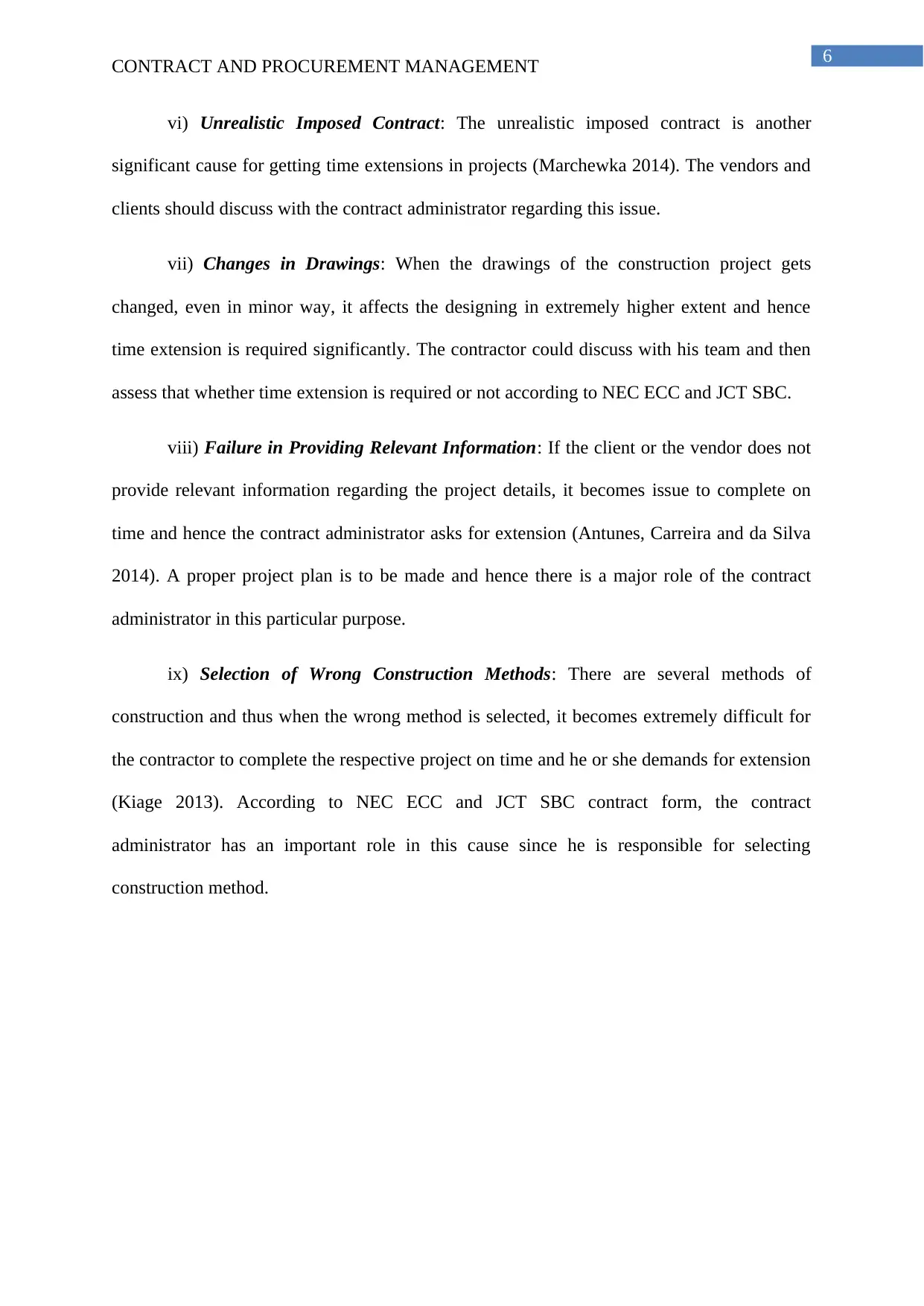
6
CONTRACT AND PROCUREMENT MANAGEMENT
vi) Unrealistic Imposed Contract: The unrealistic imposed contract is another
significant cause for getting time extensions in projects (Marchewka 2014). The vendors and
clients should discuss with the contract administrator regarding this issue.
vii) Changes in Drawings: When the drawings of the construction project gets
changed, even in minor way, it affects the designing in extremely higher extent and hence
time extension is required significantly. The contractor could discuss with his team and then
assess that whether time extension is required or not according to NEC ECC and JCT SBC.
viii) Failure in Providing Relevant Information: If the client or the vendor does not
provide relevant information regarding the project details, it becomes issue to complete on
time and hence the contract administrator asks for extension (Antunes, Carreira and da Silva
2014). A proper project plan is to be made and hence there is a major role of the contract
administrator in this particular purpose.
ix) Selection of Wrong Construction Methods: There are several methods of
construction and thus when the wrong method is selected, it becomes extremely difficult for
the contractor to complete the respective project on time and he or she demands for extension
(Kiage 2013). According to NEC ECC and JCT SBC contract form, the contract
administrator has an important role in this cause since he is responsible for selecting
construction method.
CONTRACT AND PROCUREMENT MANAGEMENT
vi) Unrealistic Imposed Contract: The unrealistic imposed contract is another
significant cause for getting time extensions in projects (Marchewka 2014). The vendors and
clients should discuss with the contract administrator regarding this issue.
vii) Changes in Drawings: When the drawings of the construction project gets
changed, even in minor way, it affects the designing in extremely higher extent and hence
time extension is required significantly. The contractor could discuss with his team and then
assess that whether time extension is required or not according to NEC ECC and JCT SBC.
viii) Failure in Providing Relevant Information: If the client or the vendor does not
provide relevant information regarding the project details, it becomes issue to complete on
time and hence the contract administrator asks for extension (Antunes, Carreira and da Silva
2014). A proper project plan is to be made and hence there is a major role of the contract
administrator in this particular purpose.
ix) Selection of Wrong Construction Methods: There are several methods of
construction and thus when the wrong method is selected, it becomes extremely difficult for
the contractor to complete the respective project on time and he or she demands for extension
(Kiage 2013). According to NEC ECC and JCT SBC contract form, the contract
administrator has an important role in this cause since he is responsible for selecting
construction method.
Paraphrase This Document
Need a fresh take? Get an instant paraphrase of this document with our AI Paraphraser
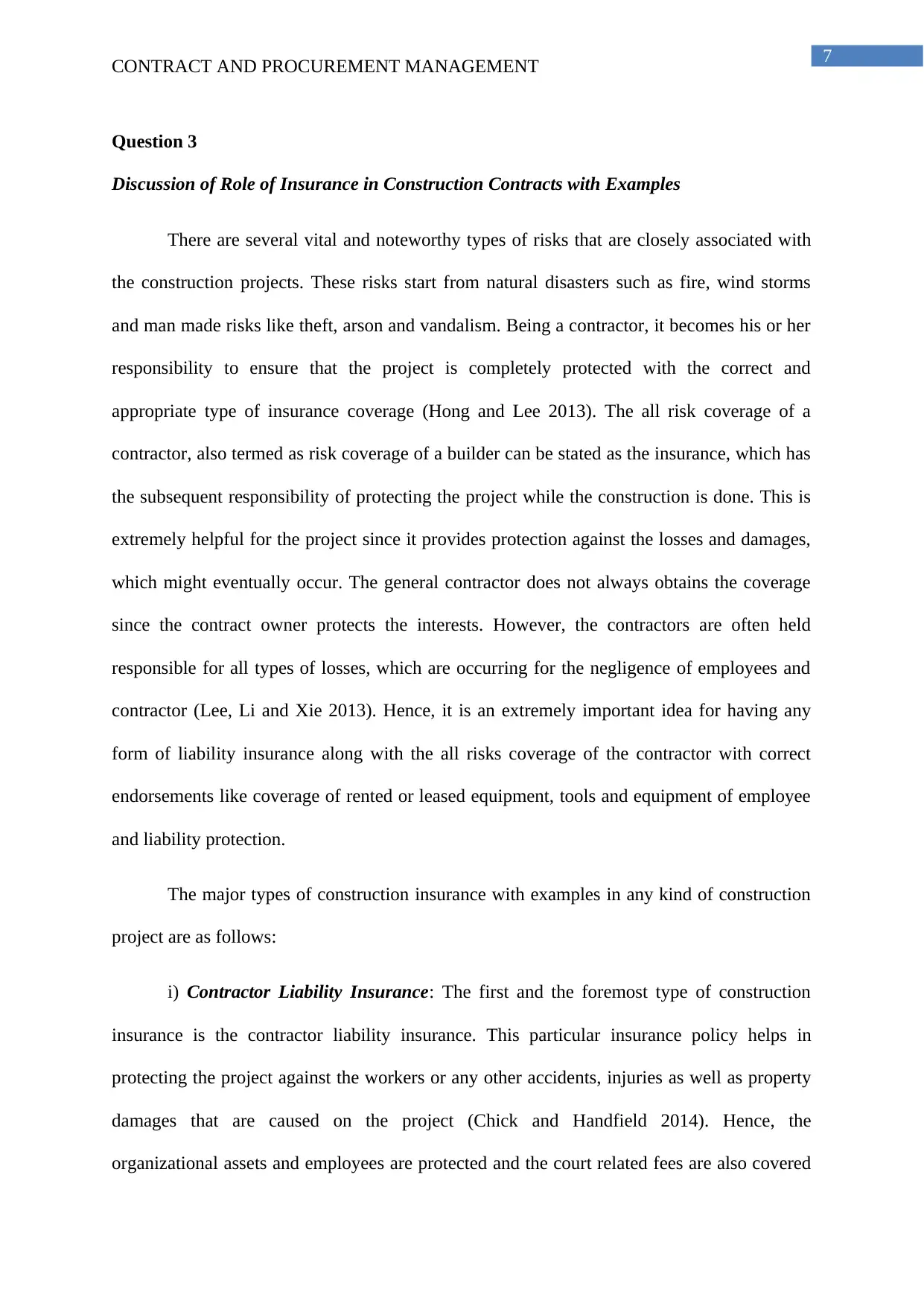
7
CONTRACT AND PROCUREMENT MANAGEMENT
Question 3
Discussion of Role of Insurance in Construction Contracts with Examples
There are several vital and noteworthy types of risks that are closely associated with
the construction projects. These risks start from natural disasters such as fire, wind storms
and man made risks like theft, arson and vandalism. Being a contractor, it becomes his or her
responsibility to ensure that the project is completely protected with the correct and
appropriate type of insurance coverage (Hong and Lee 2013). The all risk coverage of a
contractor, also termed as risk coverage of a builder can be stated as the insurance, which has
the subsequent responsibility of protecting the project while the construction is done. This is
extremely helpful for the project since it provides protection against the losses and damages,
which might eventually occur. The general contractor does not always obtains the coverage
since the contract owner protects the interests. However, the contractors are often held
responsible for all types of losses, which are occurring for the negligence of employees and
contractor (Lee, Li and Xie 2013). Hence, it is an extremely important idea for having any
form of liability insurance along with the all risks coverage of the contractor with correct
endorsements like coverage of rented or leased equipment, tools and equipment of employee
and liability protection.
The major types of construction insurance with examples in any kind of construction
project are as follows:
i) Contractor Liability Insurance: The first and the foremost type of construction
insurance is the contractor liability insurance. This particular insurance policy helps in
protecting the project against the workers or any other accidents, injuries as well as property
damages that are caused on the project (Chick and Handfield 2014). Hence, the
organizational assets and employees are protected and the court related fees are also covered
CONTRACT AND PROCUREMENT MANAGEMENT
Question 3
Discussion of Role of Insurance in Construction Contracts with Examples
There are several vital and noteworthy types of risks that are closely associated with
the construction projects. These risks start from natural disasters such as fire, wind storms
and man made risks like theft, arson and vandalism. Being a contractor, it becomes his or her
responsibility to ensure that the project is completely protected with the correct and
appropriate type of insurance coverage (Hong and Lee 2013). The all risk coverage of a
contractor, also termed as risk coverage of a builder can be stated as the insurance, which has
the subsequent responsibility of protecting the project while the construction is done. This is
extremely helpful for the project since it provides protection against the losses and damages,
which might eventually occur. The general contractor does not always obtains the coverage
since the contract owner protects the interests. However, the contractors are often held
responsible for all types of losses, which are occurring for the negligence of employees and
contractor (Lee, Li and Xie 2013). Hence, it is an extremely important idea for having any
form of liability insurance along with the all risks coverage of the contractor with correct
endorsements like coverage of rented or leased equipment, tools and equipment of employee
and liability protection.
The major types of construction insurance with examples in any kind of construction
project are as follows:
i) Contractor Liability Insurance: The first and the foremost type of construction
insurance is the contractor liability insurance. This particular insurance policy helps in
protecting the project against the workers or any other accidents, injuries as well as property
damages that are caused on the project (Chick and Handfield 2014). Hence, the
organizational assets and employees are protected and the court related fees are also covered
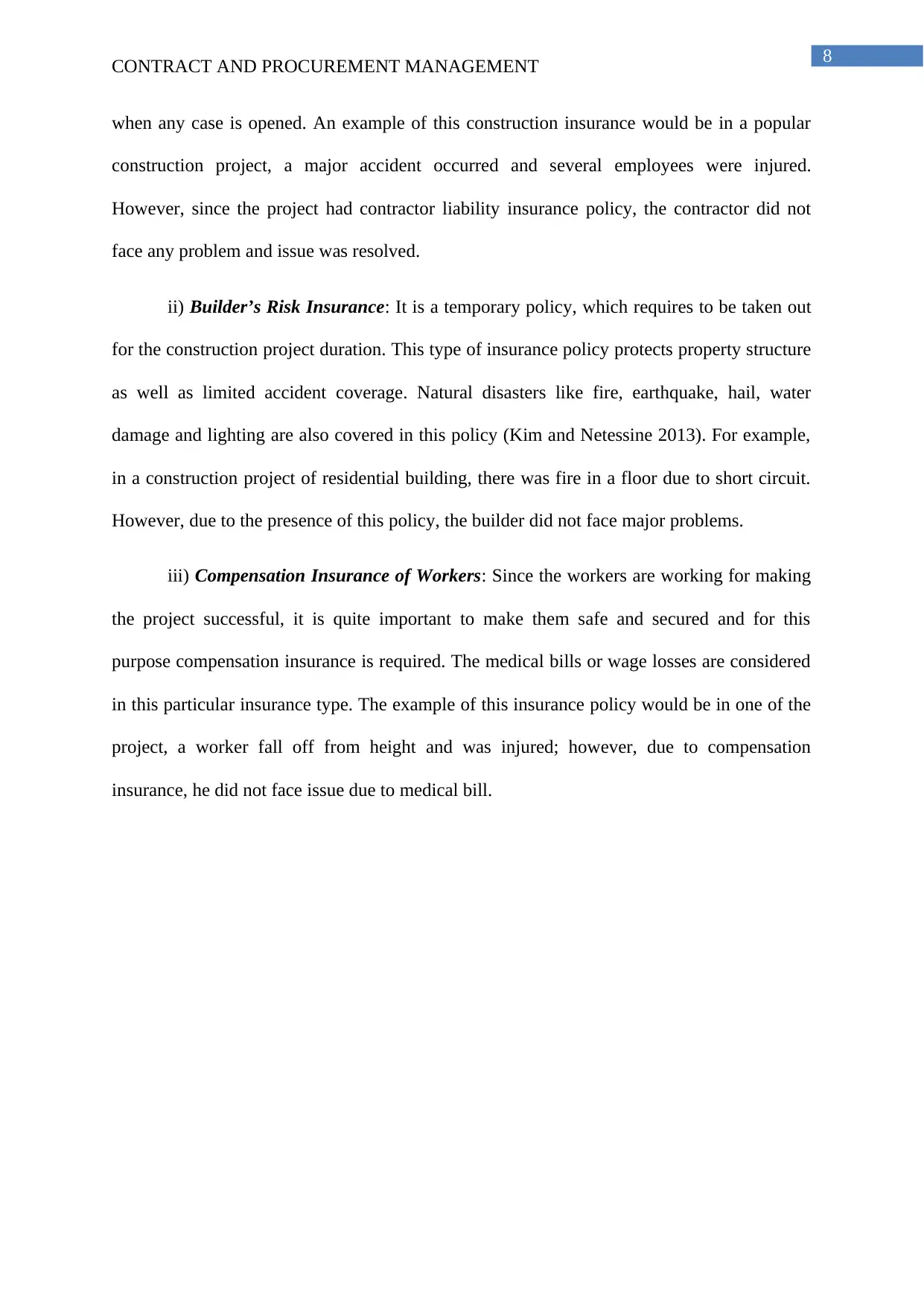
8
CONTRACT AND PROCUREMENT MANAGEMENT
when any case is opened. An example of this construction insurance would be in a popular
construction project, a major accident occurred and several employees were injured.
However, since the project had contractor liability insurance policy, the contractor did not
face any problem and issue was resolved.
ii) Builder’s Risk Insurance: It is a temporary policy, which requires to be taken out
for the construction project duration. This type of insurance policy protects property structure
as well as limited accident coverage. Natural disasters like fire, earthquake, hail, water
damage and lighting are also covered in this policy (Kim and Netessine 2013). For example,
in a construction project of residential building, there was fire in a floor due to short circuit.
However, due to the presence of this policy, the builder did not face major problems.
iii) Compensation Insurance of Workers: Since the workers are working for making
the project successful, it is quite important to make them safe and secured and for this
purpose compensation insurance is required. The medical bills or wage losses are considered
in this particular insurance type. The example of this insurance policy would be in one of the
project, a worker fall off from height and was injured; however, due to compensation
insurance, he did not face issue due to medical bill.
CONTRACT AND PROCUREMENT MANAGEMENT
when any case is opened. An example of this construction insurance would be in a popular
construction project, a major accident occurred and several employees were injured.
However, since the project had contractor liability insurance policy, the contractor did not
face any problem and issue was resolved.
ii) Builder’s Risk Insurance: It is a temporary policy, which requires to be taken out
for the construction project duration. This type of insurance policy protects property structure
as well as limited accident coverage. Natural disasters like fire, earthquake, hail, water
damage and lighting are also covered in this policy (Kim and Netessine 2013). For example,
in a construction project of residential building, there was fire in a floor due to short circuit.
However, due to the presence of this policy, the builder did not face major problems.
iii) Compensation Insurance of Workers: Since the workers are working for making
the project successful, it is quite important to make them safe and secured and for this
purpose compensation insurance is required. The medical bills or wage losses are considered
in this particular insurance type. The example of this insurance policy would be in one of the
project, a worker fall off from height and was injured; however, due to compensation
insurance, he did not face issue due to medical bill.
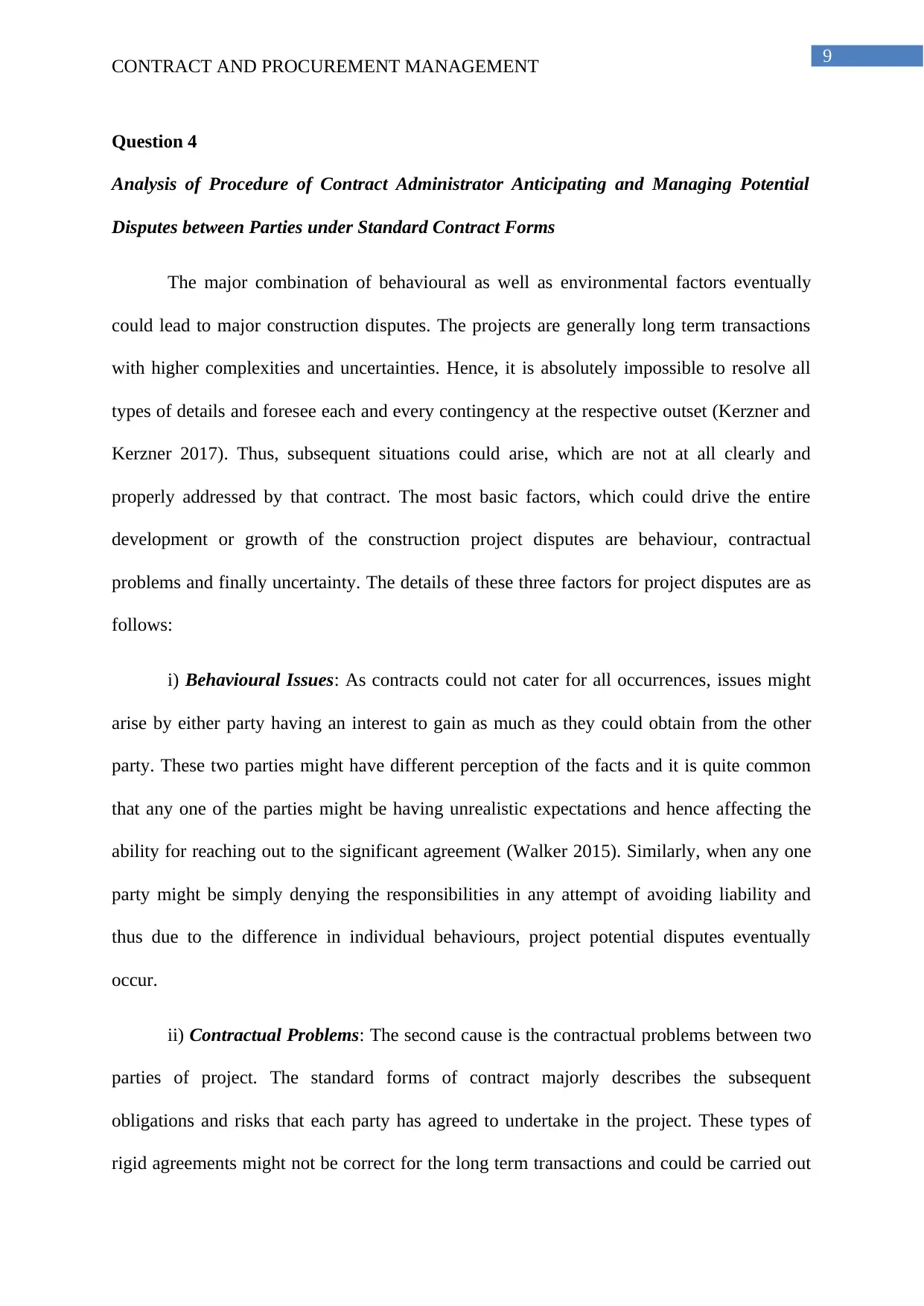
9
CONTRACT AND PROCUREMENT MANAGEMENT
Question 4
Analysis of Procedure of Contract Administrator Anticipating and Managing Potential
Disputes between Parties under Standard Contract Forms
The major combination of behavioural as well as environmental factors eventually
could lead to major construction disputes. The projects are generally long term transactions
with higher complexities and uncertainties. Hence, it is absolutely impossible to resolve all
types of details and foresee each and every contingency at the respective outset (Kerzner and
Kerzner 2017). Thus, subsequent situations could arise, which are not at all clearly and
properly addressed by that contract. The most basic factors, which could drive the entire
development or growth of the construction project disputes are behaviour, contractual
problems and finally uncertainty. The details of these three factors for project disputes are as
follows:
i) Behavioural Issues: As contracts could not cater for all occurrences, issues might
arise by either party having an interest to gain as much as they could obtain from the other
party. These two parties might have different perception of the facts and it is quite common
that any one of the parties might be having unrealistic expectations and hence affecting the
ability for reaching out to the significant agreement (Walker 2015). Similarly, when any one
party might be simply denying the responsibilities in any attempt of avoiding liability and
thus due to the difference in individual behaviours, project potential disputes eventually
occur.
ii) Contractual Problems: The second cause is the contractual problems between two
parties of project. The standard forms of contract majorly describes the subsequent
obligations and risks that each party has agreed to undertake in the project. These types of
rigid agreements might not be correct for the long term transactions and could be carried out
CONTRACT AND PROCUREMENT MANAGEMENT
Question 4
Analysis of Procedure of Contract Administrator Anticipating and Managing Potential
Disputes between Parties under Standard Contract Forms
The major combination of behavioural as well as environmental factors eventually
could lead to major construction disputes. The projects are generally long term transactions
with higher complexities and uncertainties. Hence, it is absolutely impossible to resolve all
types of details and foresee each and every contingency at the respective outset (Kerzner and
Kerzner 2017). Thus, subsequent situations could arise, which are not at all clearly and
properly addressed by that contract. The most basic factors, which could drive the entire
development or growth of the construction project disputes are behaviour, contractual
problems and finally uncertainty. The details of these three factors for project disputes are as
follows:
i) Behavioural Issues: As contracts could not cater for all occurrences, issues might
arise by either party having an interest to gain as much as they could obtain from the other
party. These two parties might have different perception of the facts and it is quite common
that any one of the parties might be having unrealistic expectations and hence affecting the
ability for reaching out to the significant agreement (Walker 2015). Similarly, when any one
party might be simply denying the responsibilities in any attempt of avoiding liability and
thus due to the difference in individual behaviours, project potential disputes eventually
occur.
ii) Contractual Problems: The second cause is the contractual problems between two
parties of project. The standard forms of contract majorly describes the subsequent
obligations and risks that each party has agreed to undertake in the project. These types of
rigid agreements might not be correct for the long term transactions and could be carried out
Secure Best Marks with AI Grader
Need help grading? Try our AI Grader for instant feedback on your assignments.
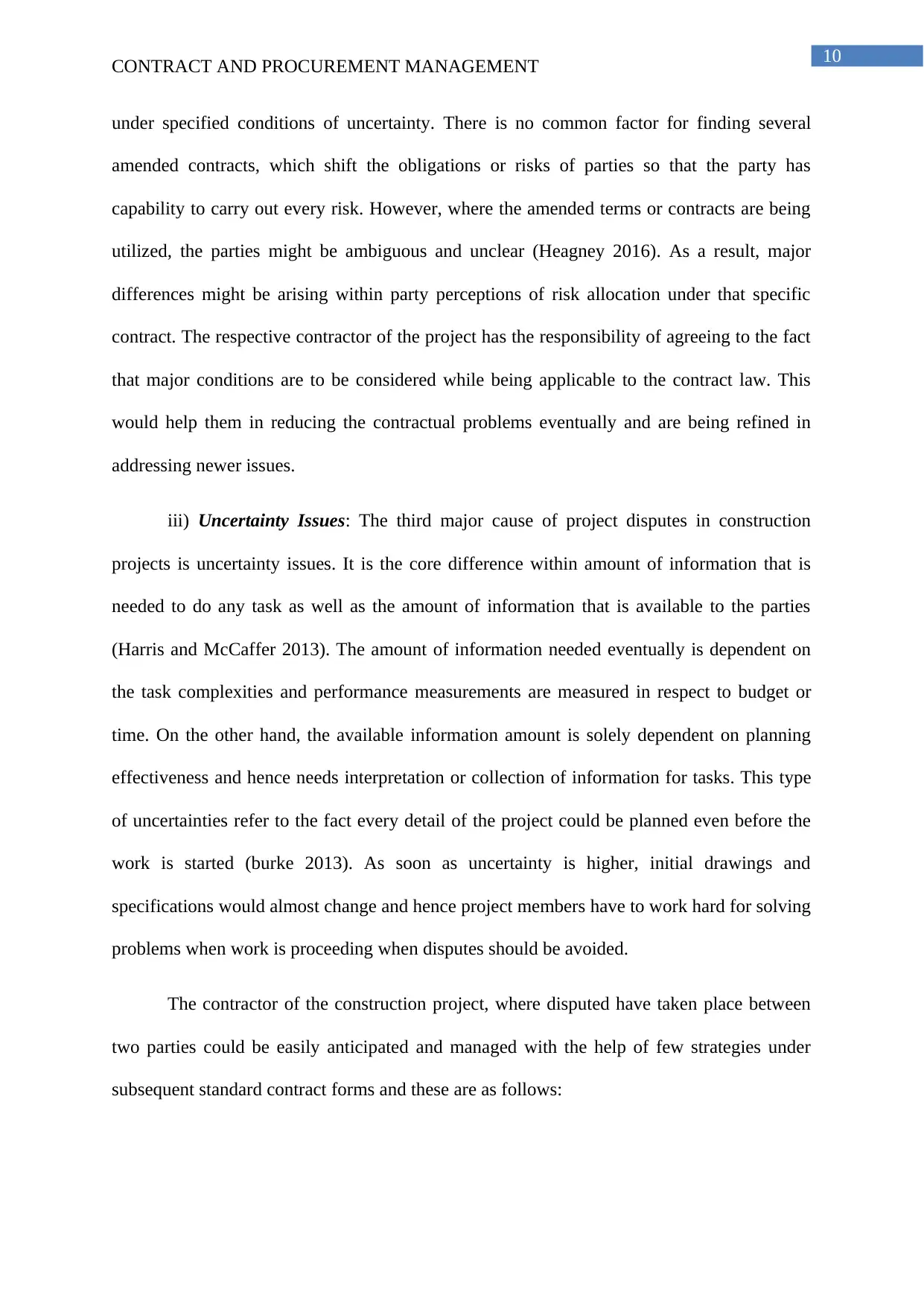
10
CONTRACT AND PROCUREMENT MANAGEMENT
under specified conditions of uncertainty. There is no common factor for finding several
amended contracts, which shift the obligations or risks of parties so that the party has
capability to carry out every risk. However, where the amended terms or contracts are being
utilized, the parties might be ambiguous and unclear (Heagney 2016). As a result, major
differences might be arising within party perceptions of risk allocation under that specific
contract. The respective contractor of the project has the responsibility of agreeing to the fact
that major conditions are to be considered while being applicable to the contract law. This
would help them in reducing the contractual problems eventually and are being refined in
addressing newer issues.
iii) Uncertainty Issues: The third major cause of project disputes in construction
projects is uncertainty issues. It is the core difference within amount of information that is
needed to do any task as well as the amount of information that is available to the parties
(Harris and McCaffer 2013). The amount of information needed eventually is dependent on
the task complexities and performance measurements are measured in respect to budget or
time. On the other hand, the available information amount is solely dependent on planning
effectiveness and hence needs interpretation or collection of information for tasks. This type
of uncertainties refer to the fact every detail of the project could be planned even before the
work is started (burke 2013). As soon as uncertainty is higher, initial drawings and
specifications would almost change and hence project members have to work hard for solving
problems when work is proceeding when disputes should be avoided.
The contractor of the construction project, where disputed have taken place between
two parties could be easily anticipated and managed with the help of few strategies under
subsequent standard contract forms and these are as follows:
CONTRACT AND PROCUREMENT MANAGEMENT
under specified conditions of uncertainty. There is no common factor for finding several
amended contracts, which shift the obligations or risks of parties so that the party has
capability to carry out every risk. However, where the amended terms or contracts are being
utilized, the parties might be ambiguous and unclear (Heagney 2016). As a result, major
differences might be arising within party perceptions of risk allocation under that specific
contract. The respective contractor of the project has the responsibility of agreeing to the fact
that major conditions are to be considered while being applicable to the contract law. This
would help them in reducing the contractual problems eventually and are being refined in
addressing newer issues.
iii) Uncertainty Issues: The third major cause of project disputes in construction
projects is uncertainty issues. It is the core difference within amount of information that is
needed to do any task as well as the amount of information that is available to the parties
(Harris and McCaffer 2013). The amount of information needed eventually is dependent on
the task complexities and performance measurements are measured in respect to budget or
time. On the other hand, the available information amount is solely dependent on planning
effectiveness and hence needs interpretation or collection of information for tasks. This type
of uncertainties refer to the fact every detail of the project could be planned even before the
work is started (burke 2013). As soon as uncertainty is higher, initial drawings and
specifications would almost change and hence project members have to work hard for solving
problems when work is proceeding when disputes should be avoided.
The contractor of the construction project, where disputed have taken place between
two parties could be easily anticipated and managed with the help of few strategies under
subsequent standard contract forms and these are as follows:
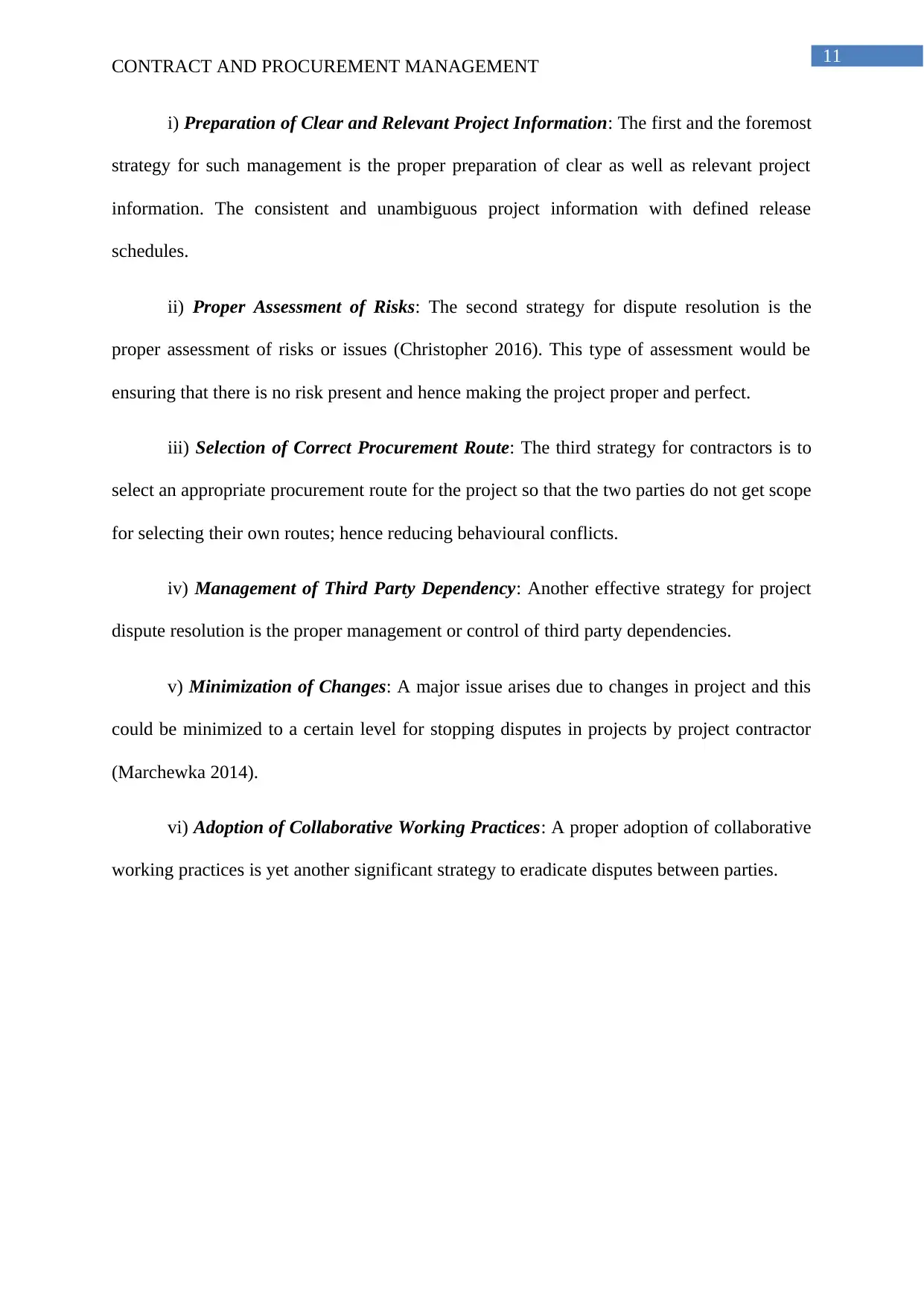
11
CONTRACT AND PROCUREMENT MANAGEMENT
i) Preparation of Clear and Relevant Project Information: The first and the foremost
strategy for such management is the proper preparation of clear as well as relevant project
information. The consistent and unambiguous project information with defined release
schedules.
ii) Proper Assessment of Risks: The second strategy for dispute resolution is the
proper assessment of risks or issues (Christopher 2016). This type of assessment would be
ensuring that there is no risk present and hence making the project proper and perfect.
iii) Selection of Correct Procurement Route: The third strategy for contractors is to
select an appropriate procurement route for the project so that the two parties do not get scope
for selecting their own routes; hence reducing behavioural conflicts.
iv) Management of Third Party Dependency: Another effective strategy for project
dispute resolution is the proper management or control of third party dependencies.
v) Minimization of Changes: A major issue arises due to changes in project and this
could be minimized to a certain level for stopping disputes in projects by project contractor
(Marchewka 2014).
vi) Adoption of Collaborative Working Practices: A proper adoption of collaborative
working practices is yet another significant strategy to eradicate disputes between parties.
CONTRACT AND PROCUREMENT MANAGEMENT
i) Preparation of Clear and Relevant Project Information: The first and the foremost
strategy for such management is the proper preparation of clear as well as relevant project
information. The consistent and unambiguous project information with defined release
schedules.
ii) Proper Assessment of Risks: The second strategy for dispute resolution is the
proper assessment of risks or issues (Christopher 2016). This type of assessment would be
ensuring that there is no risk present and hence making the project proper and perfect.
iii) Selection of Correct Procurement Route: The third strategy for contractors is to
select an appropriate procurement route for the project so that the two parties do not get scope
for selecting their own routes; hence reducing behavioural conflicts.
iv) Management of Third Party Dependency: Another effective strategy for project
dispute resolution is the proper management or control of third party dependencies.
v) Minimization of Changes: A major issue arises due to changes in project and this
could be minimized to a certain level for stopping disputes in projects by project contractor
(Marchewka 2014).
vi) Adoption of Collaborative Working Practices: A proper adoption of collaborative
working practices is yet another significant strategy to eradicate disputes between parties.
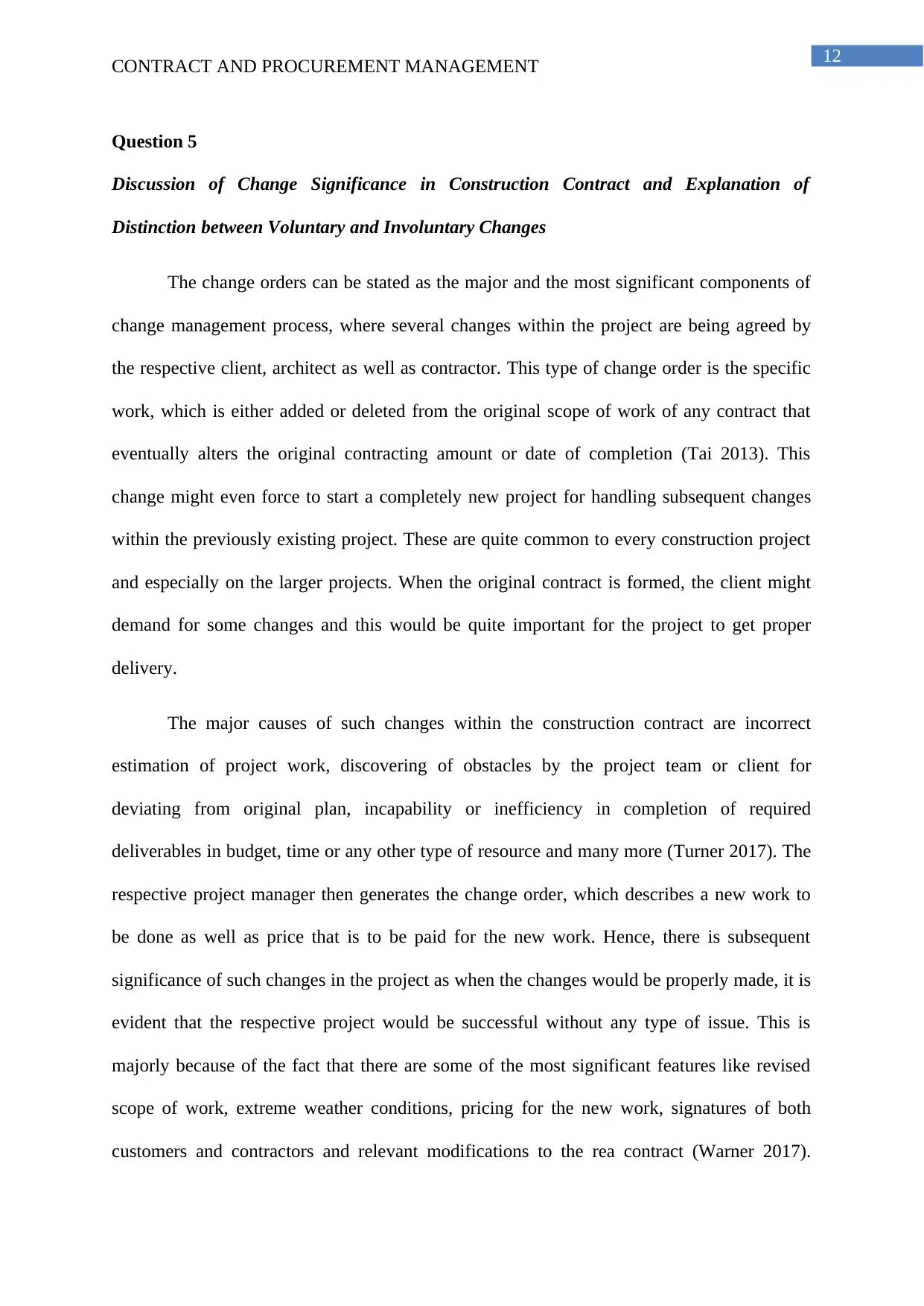
12
CONTRACT AND PROCUREMENT MANAGEMENT
Question 5
Discussion of Change Significance in Construction Contract and Explanation of
Distinction between Voluntary and Involuntary Changes
The change orders can be stated as the major and the most significant components of
change management process, where several changes within the project are being agreed by
the respective client, architect as well as contractor. This type of change order is the specific
work, which is either added or deleted from the original scope of work of any contract that
eventually alters the original contracting amount or date of completion (Tai 2013). This
change might even force to start a completely new project for handling subsequent changes
within the previously existing project. These are quite common to every construction project
and especially on the larger projects. When the original contract is formed, the client might
demand for some changes and this would be quite important for the project to get proper
delivery.
The major causes of such changes within the construction contract are incorrect
estimation of project work, discovering of obstacles by the project team or client for
deviating from original plan, incapability or inefficiency in completion of required
deliverables in budget, time or any other type of resource and many more (Turner 2017). The
respective project manager then generates the change order, which describes a new work to
be done as well as price that is to be paid for the new work. Hence, there is subsequent
significance of such changes in the project as when the changes would be properly made, it is
evident that the respective project would be successful without any type of issue. This is
majorly because of the fact that there are some of the most significant features like revised
scope of work, extreme weather conditions, pricing for the new work, signatures of both
customers and contractors and relevant modifications to the rea contract (Warner 2017).
CONTRACT AND PROCUREMENT MANAGEMENT
Question 5
Discussion of Change Significance in Construction Contract and Explanation of
Distinction between Voluntary and Involuntary Changes
The change orders can be stated as the major and the most significant components of
change management process, where several changes within the project are being agreed by
the respective client, architect as well as contractor. This type of change order is the specific
work, which is either added or deleted from the original scope of work of any contract that
eventually alters the original contracting amount or date of completion (Tai 2013). This
change might even force to start a completely new project for handling subsequent changes
within the previously existing project. These are quite common to every construction project
and especially on the larger projects. When the original contract is formed, the client might
demand for some changes and this would be quite important for the project to get proper
delivery.
The major causes of such changes within the construction contract are incorrect
estimation of project work, discovering of obstacles by the project team or client for
deviating from original plan, incapability or inefficiency in completion of required
deliverables in budget, time or any other type of resource and many more (Turner 2017). The
respective project manager then generates the change order, which describes a new work to
be done as well as price that is to be paid for the new work. Hence, there is subsequent
significance of such changes in the project as when the changes would be properly made, it is
evident that the respective project would be successful without any type of issue. This is
majorly because of the fact that there are some of the most significant features like revised
scope of work, extreme weather conditions, pricing for the new work, signatures of both
customers and contractors and relevant modifications to the rea contract (Warner 2017).
Paraphrase This Document
Need a fresh take? Get an instant paraphrase of this document with our AI Paraphraser
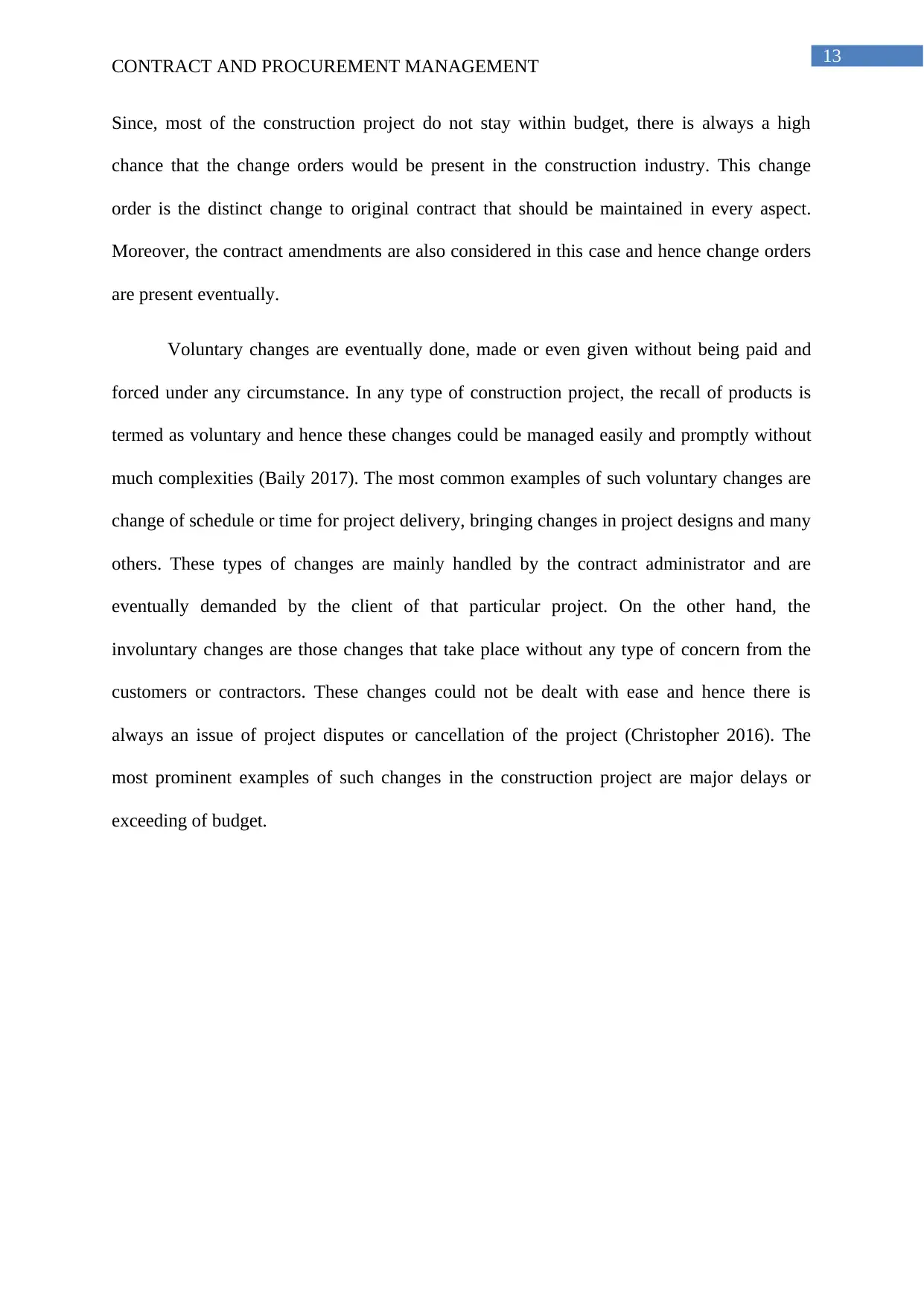
13
CONTRACT AND PROCUREMENT MANAGEMENT
Since, most of the construction project do not stay within budget, there is always a high
chance that the change orders would be present in the construction industry. This change
order is the distinct change to original contract that should be maintained in every aspect.
Moreover, the contract amendments are also considered in this case and hence change orders
are present eventually.
Voluntary changes are eventually done, made or even given without being paid and
forced under any circumstance. In any type of construction project, the recall of products is
termed as voluntary and hence these changes could be managed easily and promptly without
much complexities (Baily 2017). The most common examples of such voluntary changes are
change of schedule or time for project delivery, bringing changes in project designs and many
others. These types of changes are mainly handled by the contract administrator and are
eventually demanded by the client of that particular project. On the other hand, the
involuntary changes are those changes that take place without any type of concern from the
customers or contractors. These changes could not be dealt with ease and hence there is
always an issue of project disputes or cancellation of the project (Christopher 2016). The
most prominent examples of such changes in the construction project are major delays or
exceeding of budget.
CONTRACT AND PROCUREMENT MANAGEMENT
Since, most of the construction project do not stay within budget, there is always a high
chance that the change orders would be present in the construction industry. This change
order is the distinct change to original contract that should be maintained in every aspect.
Moreover, the contract amendments are also considered in this case and hence change orders
are present eventually.
Voluntary changes are eventually done, made or even given without being paid and
forced under any circumstance. In any type of construction project, the recall of products is
termed as voluntary and hence these changes could be managed easily and promptly without
much complexities (Baily 2017). The most common examples of such voluntary changes are
change of schedule or time for project delivery, bringing changes in project designs and many
others. These types of changes are mainly handled by the contract administrator and are
eventually demanded by the client of that particular project. On the other hand, the
involuntary changes are those changes that take place without any type of concern from the
customers or contractors. These changes could not be dealt with ease and hence there is
always an issue of project disputes or cancellation of the project (Christopher 2016). The
most prominent examples of such changes in the construction project are major delays or
exceeding of budget.
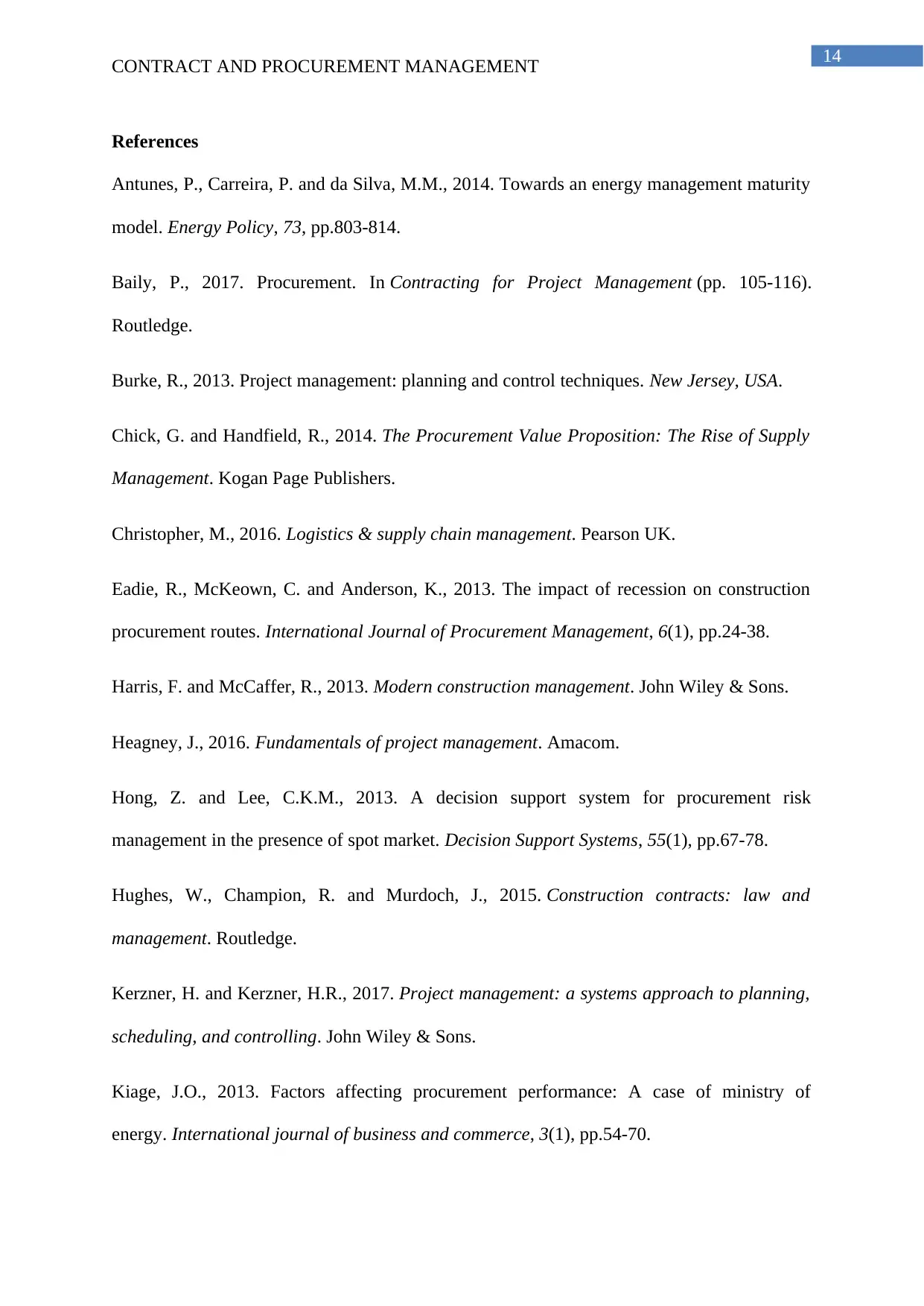
14
CONTRACT AND PROCUREMENT MANAGEMENT
References
Antunes, P., Carreira, P. and da Silva, M.M., 2014. Towards an energy management maturity
model. Energy Policy, 73, pp.803-814.
Baily, P., 2017. Procurement. In Contracting for Project Management (pp. 105-116).
Routledge.
Burke, R., 2013. Project management: planning and control techniques. New Jersey, USA.
Chick, G. and Handfield, R., 2014. The Procurement Value Proposition: The Rise of Supply
Management. Kogan Page Publishers.
Christopher, M., 2016. Logistics & supply chain management. Pearson UK.
Eadie, R., McKeown, C. and Anderson, K., 2013. The impact of recession on construction
procurement routes. International Journal of Procurement Management, 6(1), pp.24-38.
Harris, F. and McCaffer, R., 2013. Modern construction management. John Wiley & Sons.
Heagney, J., 2016. Fundamentals of project management. Amacom.
Hong, Z. and Lee, C.K.M., 2013. A decision support system for procurement risk
management in the presence of spot market. Decision Support Systems, 55(1), pp.67-78.
Hughes, W., Champion, R. and Murdoch, J., 2015. Construction contracts: law and
management. Routledge.
Kerzner, H. and Kerzner, H.R., 2017. Project management: a systems approach to planning,
scheduling, and controlling. John Wiley & Sons.
Kiage, J.O., 2013. Factors affecting procurement performance: A case of ministry of
energy. International journal of business and commerce, 3(1), pp.54-70.
CONTRACT AND PROCUREMENT MANAGEMENT
References
Antunes, P., Carreira, P. and da Silva, M.M., 2014. Towards an energy management maturity
model. Energy Policy, 73, pp.803-814.
Baily, P., 2017. Procurement. In Contracting for Project Management (pp. 105-116).
Routledge.
Burke, R., 2013. Project management: planning and control techniques. New Jersey, USA.
Chick, G. and Handfield, R., 2014. The Procurement Value Proposition: The Rise of Supply
Management. Kogan Page Publishers.
Christopher, M., 2016. Logistics & supply chain management. Pearson UK.
Eadie, R., McKeown, C. and Anderson, K., 2013. The impact of recession on construction
procurement routes. International Journal of Procurement Management, 6(1), pp.24-38.
Harris, F. and McCaffer, R., 2013. Modern construction management. John Wiley & Sons.
Heagney, J., 2016. Fundamentals of project management. Amacom.
Hong, Z. and Lee, C.K.M., 2013. A decision support system for procurement risk
management in the presence of spot market. Decision Support Systems, 55(1), pp.67-78.
Hughes, W., Champion, R. and Murdoch, J., 2015. Construction contracts: law and
management. Routledge.
Kerzner, H. and Kerzner, H.R., 2017. Project management: a systems approach to planning,
scheduling, and controlling. John Wiley & Sons.
Kiage, J.O., 2013. Factors affecting procurement performance: A case of ministry of
energy. International journal of business and commerce, 3(1), pp.54-70.
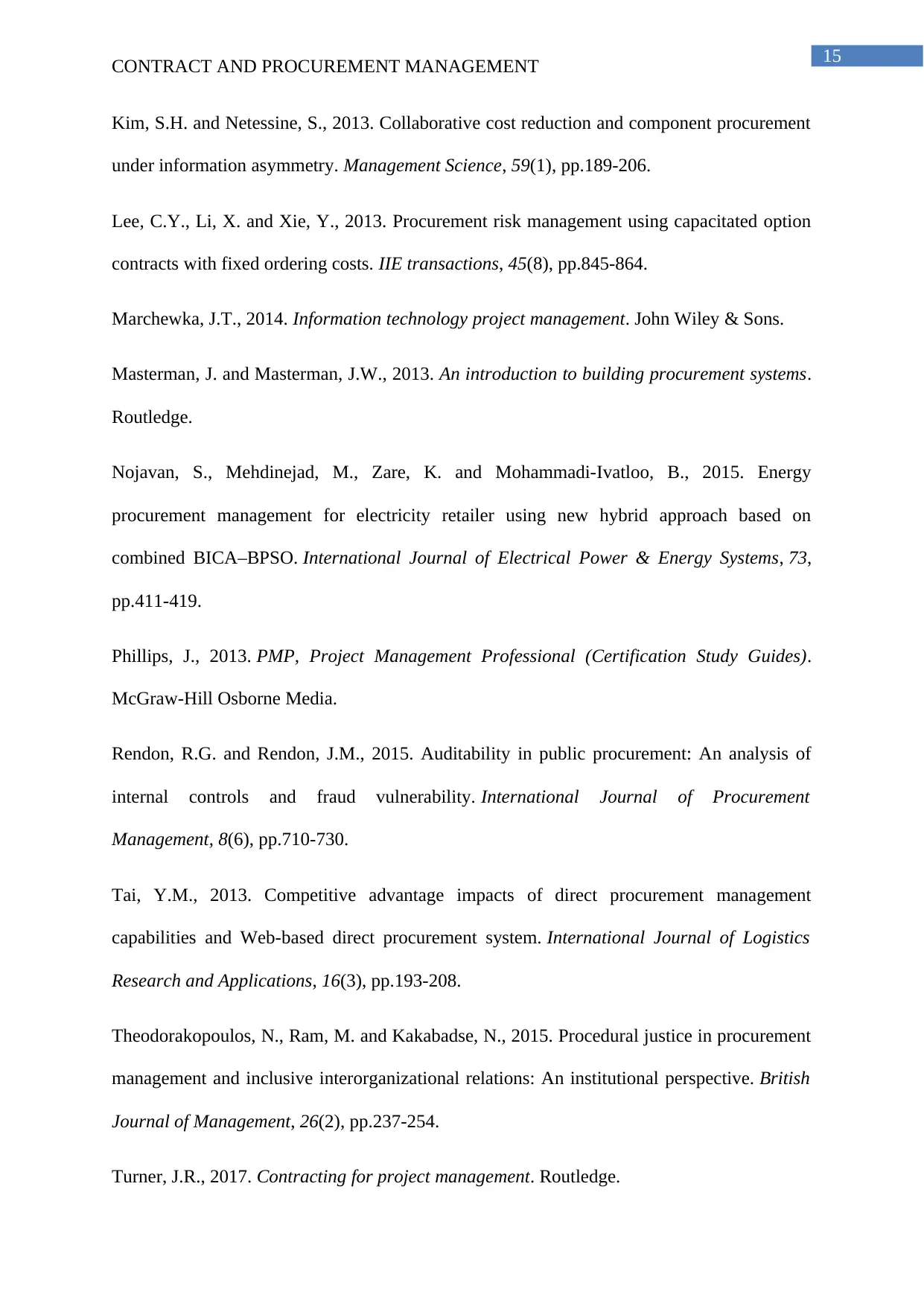
15
CONTRACT AND PROCUREMENT MANAGEMENT
Kim, S.H. and Netessine, S., 2013. Collaborative cost reduction and component procurement
under information asymmetry. Management Science, 59(1), pp.189-206.
Lee, C.Y., Li, X. and Xie, Y., 2013. Procurement risk management using capacitated option
contracts with fixed ordering costs. IIE transactions, 45(8), pp.845-864.
Marchewka, J.T., 2014. Information technology project management. John Wiley & Sons.
Masterman, J. and Masterman, J.W., 2013. An introduction to building procurement systems.
Routledge.
Nojavan, S., Mehdinejad, M., Zare, K. and Mohammadi-Ivatloo, B., 2015. Energy
procurement management for electricity retailer using new hybrid approach based on
combined BICA–BPSO. International Journal of Electrical Power & Energy Systems, 73,
pp.411-419.
Phillips, J., 2013. PMP, Project Management Professional (Certification Study Guides).
McGraw-Hill Osborne Media.
Rendon, R.G. and Rendon, J.M., 2015. Auditability in public procurement: An analysis of
internal controls and fraud vulnerability. International Journal of Procurement
Management, 8(6), pp.710-730.
Tai, Y.M., 2013. Competitive advantage impacts of direct procurement management
capabilities and Web-based direct procurement system. International Journal of Logistics
Research and Applications, 16(3), pp.193-208.
Theodorakopoulos, N., Ram, M. and Kakabadse, N., 2015. Procedural justice in procurement
management and inclusive interorganizational relations: An institutional perspective. British
Journal of Management, 26(2), pp.237-254.
Turner, J.R., 2017. Contracting for project management. Routledge.
CONTRACT AND PROCUREMENT MANAGEMENT
Kim, S.H. and Netessine, S., 2013. Collaborative cost reduction and component procurement
under information asymmetry. Management Science, 59(1), pp.189-206.
Lee, C.Y., Li, X. and Xie, Y., 2013. Procurement risk management using capacitated option
contracts with fixed ordering costs. IIE transactions, 45(8), pp.845-864.
Marchewka, J.T., 2014. Information technology project management. John Wiley & Sons.
Masterman, J. and Masterman, J.W., 2013. An introduction to building procurement systems.
Routledge.
Nojavan, S., Mehdinejad, M., Zare, K. and Mohammadi-Ivatloo, B., 2015. Energy
procurement management for electricity retailer using new hybrid approach based on
combined BICA–BPSO. International Journal of Electrical Power & Energy Systems, 73,
pp.411-419.
Phillips, J., 2013. PMP, Project Management Professional (Certification Study Guides).
McGraw-Hill Osborne Media.
Rendon, R.G. and Rendon, J.M., 2015. Auditability in public procurement: An analysis of
internal controls and fraud vulnerability. International Journal of Procurement
Management, 8(6), pp.710-730.
Tai, Y.M., 2013. Competitive advantage impacts of direct procurement management
capabilities and Web-based direct procurement system. International Journal of Logistics
Research and Applications, 16(3), pp.193-208.
Theodorakopoulos, N., Ram, M. and Kakabadse, N., 2015. Procedural justice in procurement
management and inclusive interorganizational relations: An institutional perspective. British
Journal of Management, 26(2), pp.237-254.
Turner, J.R., 2017. Contracting for project management. Routledge.
Secure Best Marks with AI Grader
Need help grading? Try our AI Grader for instant feedback on your assignments.

16
CONTRACT AND PROCUREMENT MANAGEMENT
Walker, A., 2015. Project management in construction. John Wiley & Sons.
Warner, M., 2017. Local content in procurement: creating local jobs and competitive
domestic industries in supply chains. Routledge.
CONTRACT AND PROCUREMENT MANAGEMENT
Walker, A., 2015. Project management in construction. John Wiley & Sons.
Warner, M., 2017. Local content in procurement: creating local jobs and competitive
domestic industries in supply chains. Routledge.
1 out of 17
Your All-in-One AI-Powered Toolkit for Academic Success.
+13062052269
info@desklib.com
Available 24*7 on WhatsApp / Email
![[object Object]](/_next/static/media/star-bottom.7253800d.svg)
Unlock your academic potential
© 2024 | Zucol Services PVT LTD | All rights reserved.


